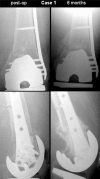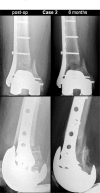Does locked plating of periprosthetic supracondylar femur fractures promote bone healing by callus formation? Two cases with opposite outcomes
- PMID: 19223952
- PMCID: PMC2603353
Does locked plating of periprosthetic supracondylar femur fractures promote bone healing by callus formation? Two cases with opposite outcomes
Abstract
Contemporary locking plates promote biological fixation through indirect reduction techniques and by elevating the plate from the bone. They have improved fixation strength in osteoporotic bone. Periarticular locking plates are rapidly being adopted for bridge plating of periprosthetic femur fractures. When these plates are used for indirect reduction and bridge plating osteosynthesis, fracture union occurs by secondary bone healing with callus formation which is stimulated by interfragmentary motion. In two patients with similar periprosthetic femur fractures treated with periarticular locking plates one fracture healed by ample callus formation while the other resulted in a non-union and had no callus formation six months post-operatively. The case, which progressed to secondary bone healing with callus formation, exhibited varus migration as a result of loss of fixation. The non-union case retained stable fixation. The difference in outcome may indicate that callus formation was promoted by interfragmentary motion secondary to loss of fixation. Conversely, in absence of fixation failure, callus formation was suppressed by stable fixation with a stiff locking plate construct which reduced interfragmentary motion. These observations suggest that locked plating constructs should be sufficiently flexible when applied for bridge plating of comminuted fractures to promote callus formation.
Figures


References
-
- Althausen PL, Lee MA, Finkemeier CG, et al. Operative stabilization of supracondylar femur fractures above total knee arthroplasty: a comparison of four treatment methods. J Arthroplasty. 2003;18:834–9. - PubMed
-
- Kregor PJ, Hughes JL, Cole PA. Fixation of distal femoral fractures above total knee arthroplasty utilizing the Less Invasive Stabilization System (L.I.S.S.) Injury. 2001;32(3):SC64–75. - PubMed
-
- Ricci WM, Loftus T, Cox C, et al. Locked plates combined with minimally invasive insertion technique for the treatment of periprosthetic supracondylar femur fractures above a total knee arthroplasty. J Orthop Trauma. 2006;20:190–6. - PubMed
-
- Egol KA, Kubiak EN, Fulkerson E, et al. Biomechanics of locked plates and screws. J Orthop Trauma. 2004;18:488–493. - PubMed
-
- Perren SM. Evolution of the internal fixation of long bone fractures. The scientific basis of biological internal fixation: choosing a new balance between stability and biology. J Bone Joint Surg Br. 2002;84:1093–110. - PubMed
Publication types
MeSH terms
LinkOut - more resources
Full Text Sources
Other Literature Sources
Medical
